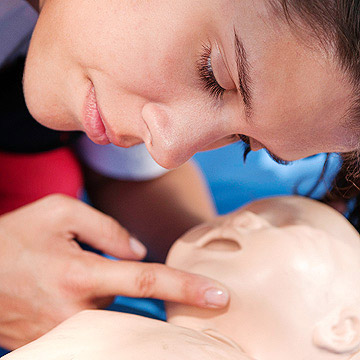
Take a class. Even if you can follow written directions, it's even better to take a class taught by an authorized American Heart Association instructor to get trained in infant and child CPR. You'll get to see these techniques performed in person with hands-on practice and real-time instructor feedback.
Get rid of anything blocking the airways. If there is something in your child's mouth, try sweeping it out with your finger. If the airway seems blocked, perform first aid for a choking baby.
If there is no obstruction present, position the infant on his back to begin the steps of CPR. Start by verifying that the scene is safe. Check for a response by shouting or tapping to decide whether or not CPR is necessary. Call out your child's name and gently tap him on the shoulder (or foot for infants). If there is no response, yell for help to call 9-1-1. Open the child's airway and check breathing. If the baby is not breathing (or not breathing normally), begin CPR.
According to the American Heart Association, performing CPR on a baby comes down to three steps:
Compressions:
1. Carefully place the baby on his back on a firm, flat surface, such as the floor or table.
2. Place two fingers on the sternum/breastbone just below the nipple line.
3. Deliver the first set of 30 compressions in about 18 seconds or less. Compress the chest about 1. 5 inches, pumping at a rate of 100-120 compressions per minute.
Airway:
After 30 compressions, gently tip the head back one hand and lift his chin slightly with the other.
Breathing:
1. Cover the baby's mouth and nose with your mouth.
2. Give a single breathof air in baby's mouth (deliver a gentle puff of air rather than a deep breath from your lungs), wait one second, and then give a second breath of air. At least one breath must result in visible chest rise. If the chest does not rise, you may need to repeat the head-tilt, chin-lift maneuver and then give the next breath. This entire step should take no more than 10 seconds. If the baby's chest still doesn't rise, examine the mouth to make sure no foreign material is inside. If an object is seen, sweep it out with your finger. If the airway seems blocked, perform first aid for a choking baby.
3. Give two breaths after every 30 chest compressions.
4. Continue CPR until you see signs of life or until medical personnel arrive.
After five cycles of CPR, if 9-1-1 has not been called, leave to phone 9-1-1 yourself, then return to the victim and continue the steps of CPR.
All content on this Web site, including medical opinion and any other health-related information, is for informational purposes only and should not be considered to be a specific diagnosis or treatment plan for any individual situation. Use of this site and the information contained herein does not create a doctor-patient relationship. Always seek the direct advice of your own doctor in connection with any questions or issues you may have regarding your own health or the health of others.

